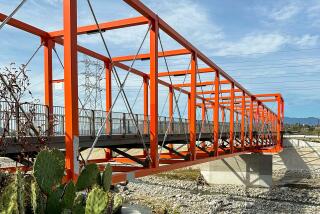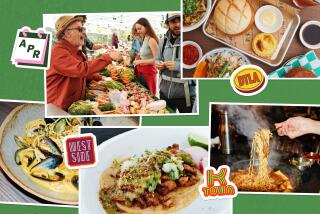Good times for San Antonio’s River Walk
Dining alfresco on the famed River Walk has its risks. Trust me. I know.
One pleasantly temperate afternoon not long ago, while gearing up to ravage a plate of chicken enchiladas slathered in verde sauce, I unrolled my cloth napkin to fetch the utensils within — and inadvertently rolled my fork into the San Antonio River.
Not to worry. Given the apparent robust economic health of the River Walk, with its bustling hotels, saloons and open-air restaurants, I suspect the fork will not be missed.
Nary a shuttered storefront can be found along the River Walk; its lush, manicured banks teem day and night with tourists and conventioneers alike. Small wonder, then, that while other destinations may be treading water amid the lingering tides of recession, Texas’ top tourist draw is moving forward full-sail.
San Antonio has embarked on a $358.3-million expansion of the River Walk that, by 2013, will see it grow south from its current three miles to more than 13. Parks and trails will link the city’s center with its four working colonial missions, making the River Walk the largest urban ecosystem in the country, those involved in the project say.
This expansion follows a shorter but no less commercially significant northward extension, finished in 2009, that tied San Antonio’s major museums to the River Walk and attracted to its banks, among other prominent businesses, a Culinary Institute of America campus focusing on Latino cuisine.
The city, the seventh largest in the U.S. in terms of population, has stepped up promotional efforts to attract more European and Asian visitors, while branding itself with a new slogan: “San Antonio. Deep. In the Heart.”
With the River Walk’s casually elegant ambiance and the historic Alamo, Texas’ second-most popular tourist stop, a short walk away, there’s plenty for out-of-towners to like.
Robert H.H. Hugman certainly would be pleased. As placards up and down the River Walk trumpet, Hugman was the San Antonio-born architect who, in 1929, came up with the Spanish-inspired plan to transform a muddy, meandering waterway that bisected the city center by paving over its banks, then building arched bridges, cobblestone pathways and stone stairs to the streets above. Hugman foresaw a veritable community within a community, with river-level shops and restaurants.
The Depression and politics delayed the start of construction until 1939. Work Projects Administration funds were used to help see it through. Finally, in April 1941, a crowd of 50,000 turned out to formally dedicate Hugman’s dream and what would soon become San Antonio’s crowning achievement.
History is never far away on the River Walk.
In 1946, a year after World War II ended, downtown businessman Alfred F. Beyer opened the first commercial establishment on the river’s edge. Beyer sold household appliances and was losing sales to San Antonio’s department stores. To augment his dwindling bank account, he dug out the basement of his own store, built stairs down to the river and opened Casa Rio restaurant. It’s still there, serving Tex-Mex dishes like there’s no mañana.
The wait for a table on weekend nights at the venerable eatery, with its tranquil setting and colorful outdoor umbrellas, can sometimes take as long as two hours. (Note to Casa Rio management, in the name of full journalistic disclosure: Your restaurant may be missing a fork. Please look in the river.)
Waitress Hortencia Escalera started working at Casa Rio shortly before the recession hit in late 2007. America’s economic malaise has done little, she says, to diminish the throngs of hungry tourists she serves each day.
“There’s a recession?” Escalara asks, smiling.
The diversity of its dining choices is one explanation of the River Walk’s staying power. Staffers at some upscale restaurants on the river report a slight downturn in business in the last three years. That, however, apparently hasn’t stopped customers from continuing to visit the River Walk and dining at other comparatively affordable eateries such as Casa Rio or Paesanos, where a plate of spaghetti with meat sauce will set you back $11.95.
“People are holding on to their money tighter, but we’re doing OK,” says Paesanos manager James Theiler who, upon being laid off from his sales job in Albuquerque, relocated to San Antonio last fall after friends boasted of its strong economy. He was hired almost immediately.
When I visited with him, Theiler noted that his place was booked that night with convention goers — not uncommon these days at Paesanos and other riverside restaurants.
In 2008, the most recent figures available, Forbes magazine ranked the River Walk as the 14th-most popular tourist destination in the United States, with 5.1 million visitors annually. That’s more than Universal Studios, New York’s Metropolitan Museum, Hawaii’s Waikiki Beach and the Grand Canyon.
To take in the full breadth of the River Walk, from its densely developed central dining and shopping district to its less-hurried outer reaches lined by walking and running paths, is to understand its wide appeal. One of the more entertaining ways to do so, with all due respect to bipeds, is to float it.
Al Beyer, the washer-dryer salesman who got things rolling by opening Casa Rio, also had the presence of mind to introduce canoes, gondolas and paddle boats as a means of ferrying paying customers to and from his restaurant. From those vessels has evolved a small fleet of tour boats (there also are dinner boats and river taxis) that are today common fixtures on the water and easily evoke comparisons to the Jungle Cruise at Disneyland.
On board, one sits back with 30 others for a cruise that lasts about 30 minutes, during which your boat driver/tour guide demonstrates his or her extensive knowledge of the river. No factoid is too remote or trivial for the telling. I learned, among other things, that the Coahuiltecan Indians who used to live along it called the river Yanaguana, which roughly means “refreshing waters.” I also learned that Michael Nesmith of the ‘60’s rock group the Monkees attended San Antonio College, which is about two miles from the River Walk, and that his mother invented Liquid Paper.
Should anyone fear falling out of a tour boat or off the pathways of the River Walk and into the San Antonio River itself, rest easy. The water is only about waist deep.
“Should we hit an iceberg,” I heard one passing boat guide telling his passengers, “you can wade ashore.”
Each January, the San Antonio Parks and Recreation Department drains and cleans the riverbed. Beer bottles are common finds, garbage crews report, as are Mardi Gras beads.
And, I’m hoping, the occasional errant fork.
More to Read
Sign up for The Wild
We’ll help you find the best places to hike, bike and run, as well as the perfect silent spots for meditation and yoga.
You may occasionally receive promotional content from the Los Angeles Times.






